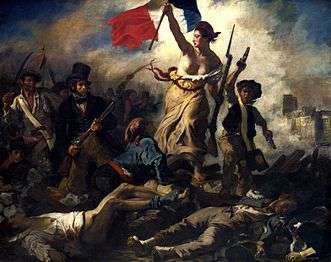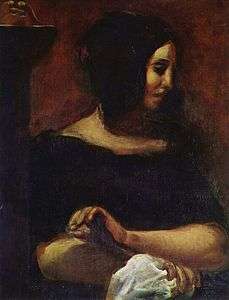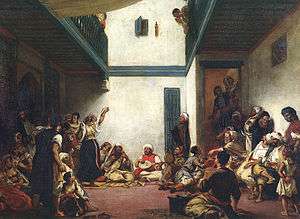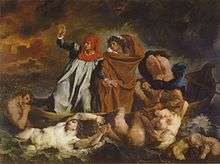Eugène Delacroix
| Eugène Delacroix | |
|---|---|
 Eugène Delacroix (portrait by Nadar) | |
| Born |
Ferdinand Victor Eugène Delacroix April 26, 1798 Charenton-Saint-Maurice, Île-de-France, France |
| Died |
August 13, 1863 (aged 65) Paris, France |
| Nationality | French |
| Known for | Painting, Lithography |
| Notable work | Liberty Leading the People, 1830 |
| Movement | Romanticism |
Ferdinand Victor Eugène Delacroix (French: [ø.ʒɛn də.la.kʁwa]; 26 April 1798 – 13 August 1863) was a French Romantic artist regarded from the outset of his career as the leader of the French Romantic school.[1]
As a painter and muralist, Delacroix's use of expressive brushstrokes and his study of the optical effects of colour profoundly shaped the work of the Impressionists, while his passion for the exotic inspired the artists of the Symbolist movement. A fine lithographer, Delacroix illustrated various works of William Shakespeare, the Scottish author Walter Scott and the German author Johann Wolfgang von Goethe.
In contrast to the Neoclassical perfectionism of his chief rival Ingres, Delacroix took for his inspiration the art of Rubens and painters of the Venetian Renaissance, with an attendant emphasis on colour and movement rather than clarity of outline and carefully modelled form. Dramatic and romantic content characterized the central themes of his maturity, and led him not to the classical models of Greek and Roman art, but to travel in North Africa, in search of the exotic.[2] Friend and spiritual heir to Théodore Géricault, Delacroix was also inspired by Lord Byron, with whom he shared a strong identification with the "forces of the sublime", of nature in often violent action.[3]
However, Delacroix was given to neither sentimentality nor bombast, and his Romanticism was that of an individualist. In the words of Baudelaire, "Delacroix was passionately in love with passion, but coldly determined to express passion as clearly as possible."[4]
Early life

Eugène Delacroix was born on 26 April 1798 at Charenton-Saint-Maurice in Île-de-France, near Paris. His mother was named Victoire, daughter of the cabinet-maker Jean-François Oeben. He had three much older siblings. Charles-Henri Delacroix (1779–1845) rose to the rank of General in the Napoleonic army. Henriette (1780–1827) married the diplomat Raymond de Verninac Saint-Maur (1762–1822). Henri was born six years later. He was killed at the Battle of Friedland on 14 June 1807.[5]
There is reason to believe that Eugène's father, Charles-François Delacroix, was infertile at the time of Eugène's conception and that his real father was Talleyrand, who was a friend of the family and successor of Charles Delacroix as Minister of Foreign Affairs, and whom the adult Eugène resembled in appearance and character.[6] Throughout his career as a painter, he was protected by Talleyrand, who served successively the Restoration and king Louis-Philippe, and ultimately as ambassador of France in Great Britain, and later by Talleyrand's grandson, Charles Auguste Louis Joseph, duc de Morny, half-brother of Napoleon III and speaker of the French House of Commons. His presumed father, Charles Delacroix, died in 1805, and his mother in 1814, leaving 16-year-old Eugène an orphan.
His early education was at the Lycée Louis-le-Grand, and at the Lycée Pierre Corneille in Rouen[7] where he steeped himself in the classics and won awards for drawing. In 1815 he began his training with Pierre-Narcisse Guérin in the neoclassical style of Jacques-Louis David. An early church commission, The Virgin of the Harvest (1819), displays a Raphael-esque influence, but another such commission, The Virgin of the Sacred Heart (1821), evidences a freer interpretation.[8] It precedes the influence of the more colourful and rich style of the Flemish painter Peter Paul Rubens (1577–1640), and fellow French artist Théodore Géricault (1791–1824), whose works marked an introduction to Romanticism in art.
The impact of Géricault's The Raft of the Medusa was profound, and stimulated Delacroix to produce his first major painting, The Barque of Dante, which was accepted by the Paris Salon in 1822. The work caused a sensation, and was largely derided by the public and officialdom, yet was purchased by the State for the Luxembourg Galleries; the pattern of widespread opposition to his work, countered by a vigorous, enlightened support, would continue throughout his life.[9] Two years later he again achieved popular success for his The Massacre at Chios.
Career
Chios and Missolonghi

Delacroix's painting of the massacre at Chios shows sick, dying Greek civilians about to be slaughtered by the Turks. One of several paintings he made of this contemporary event, it expresses sympathy for the Greek cause in their war of independence against the Turks, a popular sentiment at the time for the French people. Delacroix was quickly recognized as a leading painter in the new Romantic style, and the picture was bought by the state. His depiction of suffering was controversial however, as there was no glorious event taking place, no patriots raising their swords in valour as in David's Oath of the Horatii, only a disaster. Many critics deplored the painting's despairing tone; the artist Antoine-Jean Gros called it "a massacre of art".[9] The pathos in the depiction of an infant clutching its dead mother's breast had an especially powerful effect, although this detail was condemned as unfit for art by Delacroix's critics. A viewing of the paintings of John Constable and the watercolour sketches and art of Richard Parkes Bonnington prompted Delacroix to make extensive, freely painted changes to the sky and distant landscape.[10]
Delacroix produced a second painting in support of the Greeks in their war for independence, this time referring to the capture of Missolonghi by Turkish forces in 1825.[11] With a restraint of palette appropriate to the allegory, Greece Expiring on the Ruins of Missolonghi displays a woman in Greek costume with her breast bared, arms half-raised in an imploring gesture before the horrible scene: the suicide of the Greeks, who chose to kill themselves and destroy their city rather than surrender to the Turks. A hand is seen at the bottom, the body having been crushed by rubble. The whole picture serves as a monument to the people of Missolonghi and to the idea of freedom against tyrannical rule. This event interested Delacroix not only for his sympathies with the Greeks, but also because the poet Byron, whom Delacroix greatly admired, had died there.[1]
Romanticism

A trip to England in 1825 included visits to Thomas Lawrence and Richard Parkes Bonington, and the colour and handling of English painting provided impetus for his only full-length portrait, the elegant Portrait of Louis-Auguste Schwiter (1826–30). At roughly the same time, Delacroix was creating romantic works of numerous themes, many of which would continue to interest him for over thirty years. By 1825, he was producing lithographs illustrating Shakespeare, and soon thereafter lithographs and paintings from Goethe's Faust. Paintings such as The Combat of the Giaour and Hassan (1826), and Woman with Parrot (1827), introduced subjects of violence and sensuality which would prove to be recurrent.[12]
These various romantic strands came together in the Death of Sardanapalus (1827-8). Delacroix's painting of the death of the Assyrian king Sardanapalus shows an emotionally stirring scene alive with beautiful colours, exotic costumes and tragic events. The Death of Sardanapalus depicts the besieged king watching impassively as guards carry out his orders to kill his servants, concubines and animals. The literary source is a play by Byron, although the play does not specifically mention any massacre of concubines.[13]
Sardanapalus' attitude of calm detachment is a familiar pose in Romantic imagery in this period in Europe. The painting, which was not exhibited again for many years afterward, has been regarded by some critics as a gruesome fantasy involving death and lust. Especially shocking is the struggle of a nude woman whose throat is about to be cut, a scene placed prominently in the foreground for maximum impact. However, the sensuous beauty and exotic colours of the composition make the picture appear pleasing and shocking at the same time.
A variety of Romantic interests were again synthesized in The Murder of the Bishop of Liège (1829). It also borrowed from a literary source, this time Scott, and depicts a scene from the Middle Ages, that of the murder of Louis de Bourbon, Bishop of Liège amidst an orgy sponsored by his captor, William de la Marck. Set in an immense vaulted interior which Delacroix based on sketches of the Palais de Justice in Rouen and Westminster Hall, the drama plays out in chiaroscuro, organized around a brilliantly lit stretch of tablecloth. In 1855, a critic described the painting's vibrant handling as "Less finished than a painting, more finished than a sketch, The Murder of the Bishop of Liège was left by the painter at that supreme moment when one more stroke of the brush would have ruined everything".[14]
Liberty Leading the People

Delacroix's most influential work came in 1830 with the painting Liberty Leading the People, which for choice of subject and technique highlights the differences between the romantic approach and the neoclassical style. Less obviously, it also differs from the Romanticism of Géricault, as exemplified by The Raft of the Medusa.
"Delacroix felt his composition more vividly as a whole, thought of his figures and crowds as types, and dominated them by the symbolic figure of Republican Liberty which is one of his finest plastic inventions..."[15]
Probably Delacroix's best-known painting, Liberty Leading the People is an unforgettable image of Parisians, having taken up arms, marching forward under the banner of the tricolour representing liberty, equality, and fraternity. Although Delacroix was inspired by contemporary events to invoke this romantic image of the spirit of liberty, he seems to be trying to convey the will and character of the people,[15] rather than glorifying the actual event, the 1830 revolution against Charles X, which did little other than bring a different king, Louis-Philippe, to power. The warriors lying dead in the foreground offer poignant counterpoint to the symbolic female figure, who is illuminated triumphantly, as if in a spotlight.
.jpg)
Although the French government bought the painting, officials deemed its glorification of liberty too inflammatory and removed it from public view. Nonetheless, Delacroix still received many government commissions for murals and ceiling paintings.
Following the Revolution of 1848 that saw the end of the reign of King Louis Philippe, Delacroix' painting, Liberty Leading the People, was finally put on display by the newly elected President, Louis Napoleon (Napoleon III). Traditionally, it has been visible in the Louvre museum in Paris; beginning December, 2012, it has been on exhibit at Louvre-Lens in Lens, Pas-de-Calais.[16]
The boy holding a gun up on the right is sometimes thought to be an inspiration of the Gavroche character in Victor Hugo's 1862 novel, Les Misérables.
Travel to North Africa

In 1832, Delacroix traveled to Spain and North Africa, as part of a diplomatic mission to Morocco shortly after the French conquered Algeria. He went not primarily to study art, but to escape from the civilization of Paris, in hopes of seeing a more primitive culture.[15] He eventually produced over 100 paintings and drawings of scenes from or based on the life of the people of North Africa, and added a new and personal chapter to the interest in Orientalism.[17] Delacroix was entranced by the people and the costumes, and the trip would inform the subject matter of a great many of his future paintings. He believed that the North Africans, in their attire and their attitudes, provided a visual equivalent to the people of Classical Rome and Greece:
"The Greeks and Romans are here at my door, in the Arabs who wrap themselves in a white blanket and look like Cato or Brutus…"[15]

He managed to sketch some women secretly in Algiers, as in the painting Women of Algiers in their Apartment (1834), but generally he encountered difficulty in finding Muslim women to pose for him because of Muslim rules requiring that women be covered. Less problematic was the painting of Jewish women in North Africa, as subjects for the Jewish Wedding in Morocco (1837–41).
While in Tangier, Delacroix made many sketches of the people and the city, subjects to which he would return until the end of his life.[19] Animals—the embodiment of romantic passion—were incorporated into paintings such as Arab Horses Fighting in a Stable (1860), The Lion Hunt (of which there exist many versions, painted between 1856 and 1861), and Arab Saddling his Horse (1855).
Murals and later life
In 1838 Delacroix exhibited Medea about to Kill Her Children, which created a sensation at the Salon. His first large-scale treatment of a scene from Greek mythology, the painting depicts Medea clutching her children, dagger drawn to slay them in vengeance for her abandonment by Jason. The three nude figures form an animated pyramid, bathed in a raking light which penetrates the grotto in which Medea has hidden. Though the painting was quickly purchased by the State, Delacroix was disappointed when it was sent to the Lille Musée des Beaux-Arts; he had intended for it to hang at the Luxembourg, where it would have joined The Barque of Dante and Scenes from the Massacres of Chios.[20]
From 1833 Delacroix received numerous commissions to decorate public buildings in Paris. In that year he began work for the Salon du Roi in the Chambre des Députés, Palais Bourbon, which was not completed until 1837. For the next ten years he painted in both the Library at the Palais Bourbon and the Library at the Palais du Luxembourg. In 1843 he decorated the Church of St. Denis du Saint Sacrement with a large Pietà, and from 1848 to 1850 he painted the ceiling in the Galerie d'Apollon of the Louvre. From 1857 to 1861 he worked on frescoes for the Chapelle des Anges at the Church of St. Sulpice in Paris. They included "The Battle of Jacob with the Angel", "Saint Michael Slaying the Dragon", and "The Expulsion of Heliodorus from the Temple".[21] These commissions offered him the opportunity to compose on a large scale in an architectural setting, much as had those masters he admired, Paolo Veronese, Tintoretto, and Rubens.
The work was fatiguing, and during these years he suffered from an increasingly fragile constitution. In addition to his home in Paris, from 1844 he also lived at a small cottage in Champrosay, where he found respite in the countryside. From 1834 until his death, he was faithfully cared for by his housekeeper, Jeanne-Marie le Guillou, who zealously guarded his privacy, and whose devotion prolonged his life and his ability to continue working in his later years.[22]
In 1862 Delacroix participated in the creation of the Société Nationale des Beaux-Arts. His friend, the writer Théophile Gautier, became chairman, with the painter Aimé Millet acting as deputy chairman. In addition to Delacroix, the committee was composed of the painters Carrier-Belleuse and Puvis de Chavannes. Among the exhibitors were Léon Bonnat, Jean-Baptiste Carpeaux, Charles-François Daubigny, Gustave Doré, and Édouard Manet. Just after his death in 1863, the society organized a retrospective exhibition of 248 paintings and lithographs by Delacroix—and ceased to mount any further exhibitions.
Eugène Delacroix died in Paris and was buried there in Père Lachaise Cemetery.
His house, formerly situated along the canal of the Marne, is now near the exit of the motorway leading from Paris to central Germany.
Gallery
 Mademoiselle Rose, 1817–24, Louvre
Mademoiselle Rose, 1817–24, Louvre Louis of Orléans Unveiling his Mistress, c.1825–26, Thyssen-Bornemisza Collection
Louis of Orléans Unveiling his Mistress, c.1825–26, Thyssen-Bornemisza Collection Charles Étienne Raymond Victor de Verninac, the painter's nephew, c.1825-26
Charles Étienne Raymond Victor de Verninac, the painter's nephew, c.1825-26 The Combat of the Giaour and Hassan, 1826, Art Institute of Chicago
The Combat of the Giaour and Hassan, 1826, Art Institute of Chicago Woman with a Parrot, 1827
Woman with a Parrot, 1827 Woman With White Socks, 1825-30
Woman With White Socks, 1825-30
 The Duke of Morny's apartment, rue de Verneuil, 1831-33, Louvre
The Duke of Morny's apartment, rue de Verneuil, 1831-33, Louvre- Portrait of Dr. François-Marie Desmaisons, 1832–33, Detroit Institute of Arts
 Fantasia Arabe, 1833
Fantasia Arabe, 1833 The Women of Algiers, 1834, Louvre
The Women of Algiers, 1834, Louvre.jpg) The Natchez, 1835, Metropolitan Museum of Art
The Natchez, 1835, Metropolitan Museum of Art Frédéric Chopin, 1838, Louvre
Frédéric Chopin, 1838, Louvre George Sand, 1838, Ordrupgaard-Museum
George Sand, 1838, Ordrupgaard-Museum- Columbus and His Son at La Rábida, 1838, National Gallery of Art
 Jewish Wedding in Morocco, c.1839, Louvre
Jewish Wedding in Morocco, c.1839, Louvre
 Christ on the Sea of Galilee, 1841
Christ on the Sea of Galilee, 1841 Collision of Moorish Horsemen, 1844
Collision of Moorish Horsemen, 1844
_-_Eug%C3%A8ne_Delacroix.jpg) Desdemona Cursed by her Father (Desdemona maudite par son père), c.1850–54, Brooklyn Museum
Desdemona Cursed by her Father (Desdemona maudite par son père), c.1850–54, Brooklyn Museum 1855, Moroccan Saddles His Horse, Hermitage Museum
1855, Moroccan Saddles His Horse, Hermitage Museum Rider Attacked by a Jaguar, 1855
Rider Attacked by a Jaguar, 1855 The Bride of Abydos, 1857
The Bride of Abydos, 1857 The Death of Desdemona, 1858
The Death of Desdemona, 1858 Horses Coming Out of the Sea, 1860
Horses Coming Out of the Sea, 1860 Arab Horses Fighting in a Stable, 1860
Arab Horses Fighting in a Stable, 1860 Shipwreck on the Coast, 1862, Museum of Fine Arts, Houston
Shipwreck on the Coast, 1862, Museum of Fine Arts, Houston.jpg) Ovid among the Scythians, oil on cavas, 1862
Ovid among the Scythians, oil on cavas, 1862 Winter: Juno and Aeolus, 1856
Winter: Juno and Aeolus, 1856
Legacy



At the sale of his work in 1864, 9140 works were attributed to Delacroix, including 853 paintings, 1525 pastels and water colours, 6629 drawings, 109 lithographs, and over 60 sketch books.[23] The number and quality of the drawings, whether done for constructive purposes or to capture a spontaneous movement, underscored his explanation, "Colour always occupies me, but drawing preoccupies me." Delacroix produced several fine self-portraits, and a number of memorable portraits which seem to have been done purely for pleasure, among which were the portrait of fellow artist Baron Schwiter, an inspired small oil of the violinist Niccolò Paganini, and Portrait of Frédéric Chopin and George Sand, a double portrait of his friends, the composer Frédéric Chopin and writer George Sand; the painting was cut after his death, but the individual portraits survive.
On occasion Delacroix painted pure landscapes (The Sea at Dieppe, 1852) and still lifes (Still Life with Lobsters, 1826-7), both of which feature the virtuoso execution of his figure-based works.[24] He is also well known for his Journal, in which he gave eloquent expression to his thoughts on art and contemporary life.[25]
A generation of impressionists was inspired by Delacroix's work. Renoir and Manet made copies of his paintings, and Degas purchased the portrait of Baron Schwiter for his private collection. His painting at the church of St. Sulpice has been called the "finest mural painting of his time".[26]
Contemporary Chinese artist Yue Minjun has created his own interpretation of Delacroix's painting Massacre of Chios, which retains the same name. Yue Minjun's painting was itself sold at Sotheby's for nearly $4.1 million in 2007.[27]
His pencil drawing Moorish Conversation on a Terrace was discovered as part of the 2012 Nazi loot discovery.[28]
See also
- Jean Louis Marie Eugène Durieu, friend, colleague, and photographer
- Musée national Eugène Delacroix, his last apartment in Paris
References
- 1 2 Noon, Patrick, et al., Crossing the Channel: British and French Painting in the Age of Romanticism, p. 58, Tate Publishing, 2003. ISBN 1-85437-513-X
- ↑ Gombrich, E.H., The Story of Art, pages 504–6. Phaidon Press Limited, 1995. ISBN 0-7148-3355-X
- ↑ Clark, Kenneth, Civilisation, page 313. Harper and Row, 1969.
- ↑ Wellington, Hubert, The Journal of Eugène Delacroix, introduction, page xiv. Cornell University Press, 1980. ISBN 0-8014-9196-7
- ↑ Sjöberg, Yves (1963). Pour comprendre Delacroix. Editions Beauchesne. p. 29. GGKEY:021FPT3P5E8. Retrieved 15 March 2014.
- ↑ "Eugène Delacroix biography". Web Gallery of Art. Retrieved 2007-06-14. André Castelot (Talleyrand ou le cynisme [Paris, Librairie Perrin, 1980]) discusses and rejects the theory, pointing out that correspondence between Charles and his wife during the pregnancy shows no sign of tension or resentment.
- ↑ "Lycée Pierre Corneille de Rouen - The Lycée Corneille of Rouen". ac-rouen.fr.
- ↑ Jobert, Barthélémy, Delacroix, page 62. Princeton University Press, 1997. ISBN 0-691-00418-8
- 1 2 Wellington, page xii.
- ↑ Wellington, pages xii, 16.
- ↑ Jobert, page 127.
- ↑ Jobert, page 98.
- ↑ "'The Death of Sardanapalus' - Analysis and Critical Reception". www.artble.com. Retrieved 2015. Check date values in:
|access-date=(help) - ↑ Jobert, pages 116-18.
- 1 2 3 4 Wellington, page xv.
- ↑ "Louvre museum gets a sister". USAToday. 23 December 2012. Retrieved December 23, 2012.
- ↑ Jobert, page 140.
- ↑ Baudelaire, quoted in Jobert, page 27.
- ↑ Wellington, page xvi.
- ↑ Jobert, pages 245–6.
- ↑ Spector, Jack J. (1985). The Murals of Eugene Delacroix at Saint-Sulpice. Pennsylvania State University Press.
- ↑ Wellington, pages xxvii-xxviii.
- ↑ Wellington, page xxviii.
- ↑ Jobert, page 99.
- ↑ Eugène Delacroix, Journal, nouvelle édition intégrale établie par Michèle Hannoosh, 2 vols., Paris, José Corti, 2009. ISBN 978-2714309990.
- ↑ Wellington, page xxiii.
- ↑ "New record sale of a Chinese contemporary painting: US$5.9 million". Shanghaiist.
- ↑ "Photo Gallery: Munich Nazi Art Stash Revealed". Spiegel. 17 November 2013. Retrieved 17 November 2013.
External links
| Wikiquote has quotations related to: Eugène Delacroix |
| Wikimedia Commons has media related to Eugène Ferdinand Victor Delacroix. |
| Wikisource has the text of a 1911 Encyclopædia Britannica article about Eugène Delacroix. |
- Works by or about Eugène Delacroix at Internet Archive
- Bibliothèque numérique de l'INHA - Journal et Correspondance d'Eugène Delacroix
- Eugène Delacroix's biography, context, style and technique
- The National Gallery: Delacroix
- Brief biography at the Getty Museum
- Le musée national Eugène Delacroix (French)
- A free video documentary about Delacroix's Liberty leading the people
- Harriet Griffiths & Alister Mill, Delacroix's Salon exhibition record, 1827-1849, Database of Salon Artists, 1827-1850
- "Examination of The Shipwreck of Don Juan". Paintings & Drawings. Victoria and Albert Museum.
- Eugène Delacroix (1798-1863): Paintings, Drawings, and Prints from North American Collections, a full text exhibition catalog from The Metropolitan Museum of Art
- Romanticism & the school of nature : nineteenth-century drawings and paintings from the Karen B. Cohen collection, a full text exhibition catalog from The Metropolitan Museum of Art (see index)



